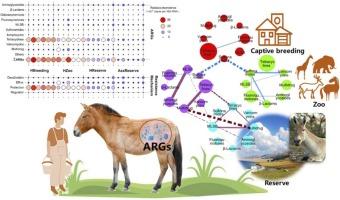粪便中 ARGs 的特征是通过重新引入普氏马逐步野化
IF 3.5
2区 环境科学与生态学
Q1 BIODIVERSITY CONSERVATION
引用次数: 0
摘要
将圈养的濒危或灭绝动物重新引入其原生栖息地具有深远的生态意义。但是,评估重新引入的 "野生 "动物的野化进展需要简明的量化指标,以整合传统的自我维持和繁殖评估。我们对中国新疆的普氏野马(一种已灭绝的旗舰食草动物)进行了粪便ARGs分析,研究对象包括繁育中心(圈养)、天山野生动物园(半圈养)和卡拉麦里自然保护区(重引进)的普氏野马。在每个地点的 6 个样本中,普氏野马的 ARGs 超过 60 个,而蒙古野驴的 ARGs 为 46 个。与人工饲养的普氏野马相比,重新引进的普氏野马粪便中的ARGs在共享数量和相对丰度上都有显著下降。重新引进的普氏野马与蒙古野驴之间在表达强度(按抗菌素类别量化的ARGs的平均相对丰度)上有复杂的粪便ARGs量化内部联系,与圈养马之间的外部联系更为明显。总体而言,普氏野马的再引入在野化方面取得了显著的渐进式成功。仅四环素抗性基因(Tetra-RGs)的全量化频率就可以定量地描述这一成就。四环素抗性基因与氨基糖苷类药物抗性基因(Amino-RGs)之比将在数量级上区分普氏野马的野化进程,在本研究中,重新引进的普氏野马为 279 个,人工饲养的为 11.7 个,而蒙古野驴为 0.86 个。这两个基于ARGs的指标可能适用于量化其他人工饲养的濒危或灭绝动物的野化进程。本文章由计算机程序翻译,如有差异,请以英文原文为准。

Fecal ARGs characterized progressive feralization of Przewalski's horses via re-introduction
Re-introduction of captive endangering or extinct animals to their native habitats holds profound ecological significance. But evaluating the feralization progress of re-introduced “wild” animals requires concise and quantitative indicator(s) to integrate traditional assessments on self-sustainability and reproduction. A fecal ARGs’ profiling was conducted for Przewalski’s horses, an extinct flagship herbivore, in Xinjiang, China from the Breeding Center (captive), Tianshan Wildlife Zoo (semi-captive), and Kalamaili Nature Reserve (re-introduction) with Mongolian wild asses serving as a reference in the shared Kalamaili range. Over 60 ARGs were quantified across 6 samples at each site for Przewalski’s horses while 46 ARGs for Mongolian wild asses. The re-introduced Przewalski’s horses had significant losses of fecal ARGs in sharing number and relative abundance in comparison to the captive ones. The re-introduced Przewalski’s horses had complex internal connections among the quantified fecal ARGs in expression intensity (average relative abundance per quantified ARGs by antimicrobial category) and even more significant external connections with Mongolian wild asses than with captive horse. Overall, the re-introduction of Przewalski’s horses achieved notable and progressive success in feralization. Tetracyclines resistance genes (Tetra-RGs) alone, with full quantification frequency, could quantitatively characterized this achievement. Ratio of Tetra-RGs to aminoglycosides resistant genes (Amino-RGs) would differentiate the feralization progress with orders of magnitude, for the re-introduced Przewalski’s horses at 279 and the captive one at 11.7, against Mongolian wild asses at 0.86 in this study. The two ARGs-based indicators might be applicable to quantify feralization progress in re-introduction of other captive endangering or extinct animals with validations.
求助全文
通过发布文献求助,成功后即可免费获取论文全文。
去求助
来源期刊

Global Ecology and Conservation
Agricultural and Biological Sciences-Ecology, Evolution, Behavior and Systematics
CiteScore
8.10
自引率
5.00%
发文量
346
审稿时长
83 days
期刊介绍:
Global Ecology and Conservation is a peer-reviewed, open-access journal covering all sub-disciplines of ecological and conservation science: from theory to practice, from molecules to ecosystems, from regional to global. The fields covered include: organismal, population, community, and ecosystem ecology; physiological, evolutionary, and behavioral ecology; and conservation science.
 求助内容:
求助内容: 应助结果提醒方式:
应助结果提醒方式:


